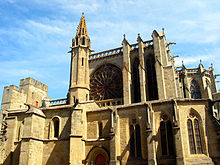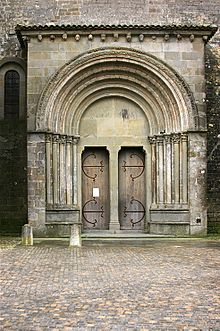
The Basilica of Saint-Denis is a large former medieval abbey church and present cathedral in the commune of Saint-Denis, a northern suburb of Paris. The building is of singular importance historically and architecturally as its choir, completed in 1144, is widely considered the first structure to employ all of the elements of Gothic architecture.

The National Basilica of the Sacred Heart is a Catholic minor basilica and parish church in Brussels, Belgium. It is dedicated to the Sacred Heart, inspired by the Basilique du Sacré-Cœur in Paris. Symbolically, King Leopold II laid the first stone in 1905 during the celebrations of the 75th anniversary of Belgian independence. The construction was halted by the two world wars and finished only in 1970. Belonging to the Metropolitan Archdiocese of Mechelen–Brussels, it is the 14th largest church by area in the world and the largest in Belgium.

The Cathedral of Saint Peter of Beauvais is a Catholic church in the northern town of Beauvais, Oise, France. It is the seat of the Bishop of Beauvais, Noyon and Senlis.

Aix Cathedral in Aix-en-Provence in southern France is a Roman Catholic church and the seat of the Archbishop of Aix-en-Provence and Arles. The cathedral is built on the site of the 1st-century Roman forum of Aix. Built and re-built from the 12th until the 19th century, it includes Romanesque, Gothic and Neo-Gothic elements, as well as Roman columns and parts of the baptistery from a 6th-century Christian church. It is a national monument of France.

Bordeaux Cathedral, officially known as the Primatial Cathedral of St Andrew of Bordeaux, is a Catholic church dedicated to Saint Andrew and located in Bordeaux, France. It is the seat of the Archbishop of Bordeaux.

The Cathedral of Saint Lazarus of Autun, commonly known as Autun Cathedral, is a Roman Catholic cathedral in Autun and a national monument of France. Famous for its Cluniac inspiration and its Romanesque sculptures by Gislebertus, it is a highlight of Romanesque art in Burgundy. It is the seat of the Bishop of Autun. The Bishop of Autun set forth the construction of St. Lazarus Cathedral as a result of the large movement of pilgrims travelling to Vezelay as they progressed on the pilgrimage route to Santiago de Compostela.

Langres Cathedral is a Roman Catholic church in Langres, France. It was erected in the twelfth century, and is dedicated to the 3rd-century martyr Mammes of Caesarea. The cathedral is the seat of the Bishop of Langres, and is a national monument. The nave and interior are in the Romanesque and French Gothic style while the later facade is an example of French Neoclassical architecture
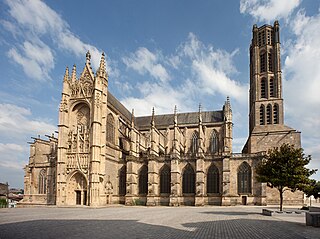
Limoges Cathedral is a Roman Catholic church located in Limoges, France. it became part of the new administrative region of Nouvelle-Aquitaine, in 2016. It is a national monument and the seat of the Bishop of Limoges.

Clermont-Ferrand Cathedral, or the Cathedral of Our Lady of the Assumption of Clermont-Ferrand, is a Gothic cathedral and French national monument located in the city of Clermont-Ferrand in the Auvergne. It is the seat of the Archbishops of Clermont.

Vannes Cathedral is a Roman Catholic church dedicated to Saint Peter in Vannes, Brittany, France. The cathedral is the seat of the Bishop of Vannes.
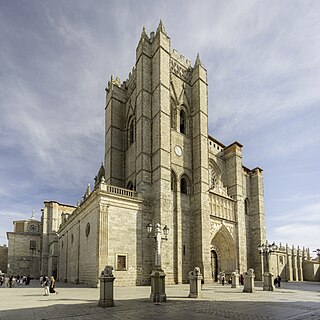
The Cathedral of the Saviour is a Catholic church in Ávila in the south of Old Castile, Spain. It was built in the late Romanesque and Gothic architectural traditions.

French Gothic architecture is an architectural style which emerged in France in 1140, and was dominant until the mid-16th century. The most notable examples are the great Gothic cathedrals of France, including Notre-Dame Cathedral, Reims Cathedral, Chartres Cathedral, and Amiens Cathedral. Its main characteristics are verticality, or height, and the use of the rib vault and flying buttresses and other architectural innovations to distribute the weight of the stone structures to supports on the outside, allowing unprecedented height and volume. The new techniques also permitted the addition of larger windows, including enormous stained glass windows, which fill the cathedrals with light.

Carcassonne Cathedral is a cathedral and designated national monument in Carcassonne, France. It is the seat of the Roman Catholic Bishop of Carcassonne and Narbonne.

Early Gothic is the term for the first period of Gothic architecture which lasted from about 1120 until about 1200. The early Gothic builders used innovative technologies to resolve the problem of masonry ceilings which were too heavy for the traditional arched barrel vault. The solutions to the problem came in the form of the rib vault, where thin stone ribs passed the weight of the ceiling to rows of columns and outside the walls to another innovation, the flying buttress.

The Basilica of Saint-Quentin, formerly the Collegiate Church of Saint-Quentin is a Catholic church in the town of Saint-Quentin, Aisne, France. There have been religious buildings on the site since the 4th century AD, which were repeatedly destroyed and rebuilt during the Early Middle Ages. The present basilica was constructed in stages between the 12th and 15th centuries. It was severely damaged in World War I (1914–18), and was only reopened in 1956 after extensive reconstruction.

The Basilica of Notre-Dame d'Alençon is a Gothic parish church located in Alençon, Orne, France. It was elevated to the rank of minor basilica by Pope Benedict XVI in 2009.
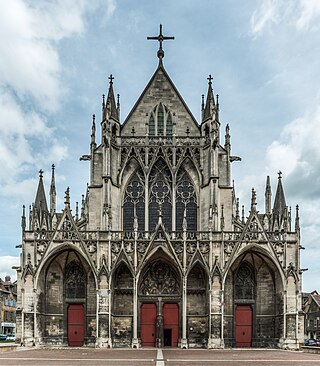
The Basilique Saint-Urbain de Troyes, formerly the Église Saint-Urbain, is a massive medieval church in the city of Troyes, France. It was a collegial church, endowed in 1262 by Pope Urban IV. It is a classic example of late 13th century Gothic architecture. The builders encountered resistance from the nuns of the nearby abbey, who caused considerable damage during construction. Much of the building took place in the 13th century, and some of the stained glass dates to that period, but completion of the church was delayed for many years due to war or lack of funding. Statuary includes excellent examples of the 16th century Troyes school. The vaulted roof and the west facade were only completed in the late 19th and early 20th centuries. It has been listed since 1840 as a monument historique by the French Ministry of Culture.

The Basilica of Saint Severinus is a church built in Bordeaux at the dawn of the 11th century.
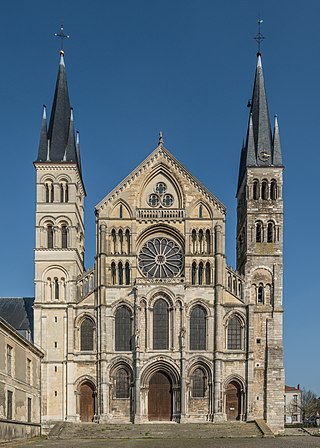
The Basilica of Saint-Remi is a medieval abbey church in Reims, France. It was founded in the 11th century "over the chapel of St. Christophe where St. Remi was buried." It is "the largest Romanesque church in northern France, though with later additions." The church has been a monument historique since 1840, and a UNESCO World Heritage Site since 1991 as a part of Cathedral of Notre-Dame, former Abbey of Saint-Remi and Palace of Tau.

The Basilica of Saint Maternus, also known as the Basilica of Our Lady is a minor basilica in Walcourt, in the Namur Province of Belgium. According to legend, an oratory was founded here by Maternus of Cologne, who also carved a Madonna to replace an earlier pagan idol. The church does in fact contain a wooden Madonna, albeit from 950 to 1020, but still one of the oldest preserved Marian devotional statues in Western Christianity. The church was consecrated in 1026. The presence of the Madonna and its allegedly miraculous properties led to the development of the church into a pilgrimage site during the Middle Ages. Subsequently, the church was rebuilt into the Gothic edifice seen today between the 13th and 16th centuries. It contains a decorated rood screen from 1521, donated by Emperor Charles V, and decorated choir stalls from the early 16th century. The church has been damaged by fire and war on several occasions, most recently in May 1940 during World War II. Since 1941 it has been a listed building, and since 1950 classified as a minor basilica.
